Sivana User Guide
Sivana User Guide
Introduction
Sivana is a unique online learning community. Our platform provides a marketplace for Instructors (tutors, teachers, coaches and mentors) from a variety of backgrounds to share their knowledge with others by creating Subjects that represent the knowledge and skills they can share with students in our live video classroom for one-on-one or group sessions. Customers can find Instructors and the Subjects they teach by browsing our catalog or using our search bar at the top of every site page.
To connect with an Instructor to learn a Subject, you'll first need to create a Sivana account from our Sign Up page.
Once a student and instructor connect, our calendar feature lets the student proactively book a meeting time based on the preset schedule provided by the instructor. When the time arrives, both student and instructor visit the video classroom page to carry out the browser-based video learning session.
To teach others, upgrade your student account to an Instructor account from your account page. Then, create one or more subjects to teach, based on your specific areas of expertise. Your subjects will be the primary way students discover you, and you can create subjects for each of your unique areas of interest.
Getting Started: Step-by-Step
- Create an account
- To create an account, click the “Join” button at the top right to reach the Join page, and enter your information. You can create your account by signing in with Google or Facebook, or with an email address.
- Become an Instructor
- Click your profile icon in the top right of the Sivana site, and in the dropdown window that appears, choose "Become an Instructor" and fill out the additional information requested. Once you’ve done this, you’re officially a Sivana Instructor. You now have the option to create your own Subjects and set your availability.
- Create a Subject
- After you've become an Instructor, the "status widget" box appears at the top of your dashboard feed, with the
option to “Create a Subject.” If you’re not sure which subjects you’d like to create right now, you can always make one later by clicking on your profile in the top right corner and selecting “My Subjects.”
- After you've become an Instructor, the "status widget" box appears at the top of your dashboard feed, with the
- Set your hours
- By default, your availability is set to 24 hours a day, seven days a week. This means a potential new student can attempt to book you for a session at any point in the day or night. (You have to approve each booking request, but this can still lead to confusion for potential students.)
- Click on the calendar icon in the website's header. On the left sidebar, click the box that reads “Set Your Teaching Schedule Availability.” You can then choose for each day of the week your specific hourly availability. To block more specific times, set your general Availability for the day (e.g. '9 AM-5 PM') on this page, return to your Schedule, then click an open time on the calendar to restrict additional time within the initial period.
- The calendar adapts to your time zone, so when you set your availability based on your working hours, it will automatically display the local hours for site visitors from other time zones around the world.
- Create a video
- Making a video to introduce yourself to potential students is a great step toward becoming a successful instructor. A video introduction highlights your personality and your expertise! Treat it like a first greeting of your future students.
- You can use any video-recording device including your computer, phone, or tablet.
- Save the video to your desktop and make sure the format is .mp4. If the video is in .mov format there are simple ways to change it to a .mp4. On a Mac, simply click on the video, press the ENTER key, and change the extension text from .mov to .mp4. The computer will then prompt you to confirm this change and upon confirmation it should be easy to upload it to Sivana.
- Make a post
- Once you’ve become an Instructor, you will see an option under the main header to “Make a Post” next to “Write an Article.” You can share a link, post a video or image, or write your own text. If you have more than one subject, be sure to choose the correct subject that you want to make the post for.
- Remember that posts are one of the ways potential students will choose an instructor, based on the personality, interests and approaches visible in the way instructors communicate and share information. Try to make your posts fit your personality and style of teaching, which will help attract students who are the best fit for you.
Become an Instructor on Sivana
Whatever your interests and skills, Sivana is a place you can share them with others. Whether that includes mentoring primary school students with their daily homework, sharing practice time with a language learning partner on the other side of the world, or covering an esoteric subject known by only a few widely-dispersed fans, Sivana is the place to find your community of learners.
After creating your Sivana account, the next step is to set yourself as an Instructor, which will allow you to invite others to your video classroom for live teaching and mentoring sessions.
When you log in as a normal user, you'll see a popup window encouraging you to become an Instructor. On this window, click the "Become an Instructor" button to reach the page where you'll add extra profile information to become an Instructor.
Alternately, you can click your user menu in the top right of the Sivana page, indicated by a thumbnail image of your profile picture, and click the "Become an Instructor" link in the dropdown menu there.
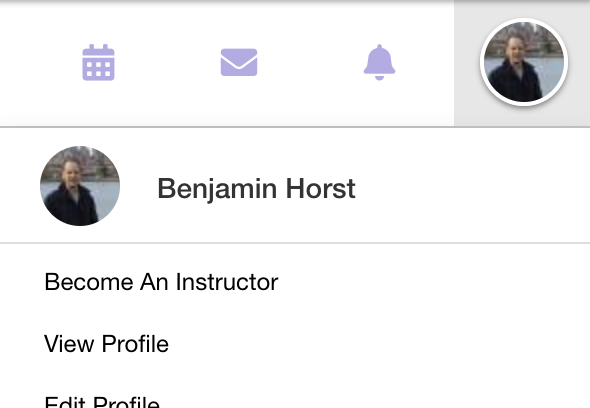
Fill out the required fields to complete the Instructor portion of your profile, and then save your changes.
Now, create a Subject explaining what you will be teaching: again, click the user menu in the top right, where you will see different options than before. Select "My Subjects and Partner Pages," which takes you to a page listing your existing subjects if you have any, and then click the "Create a Subject" button in the top right portion of the page.

Use the workflow interface to create your new Subject following the several steps. Be sure to write a thorough subject description to increase your appearance in relevant search results and show potential students the specific content you are prepared to teach. On the final step of the Subject workflow, make sure you publish the new Subject to make it publicly visible to Sivana site visitors and search engines.
Using the Video Classroom for Unscheduled Sessions
To invite students into your video classroom for an unscheduled live session, first ensure you are set up as an Instructor on Sivana. (See above for a guide on becoming an Instructor.)
As an Instructor with a Subject, click the user menu and select Enter my Classroom.
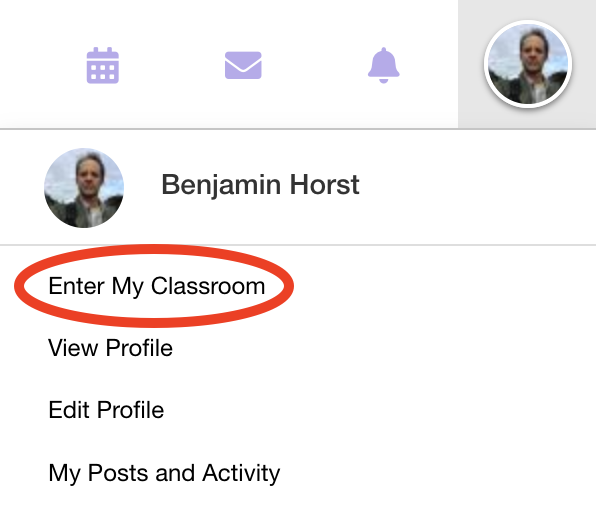
If necessary, contact your students who will join you in the video classroom (any number of one or more), and make sure they are signed in to the Sivana site.
Choose the "Start an Unscheduled Class Session" button:
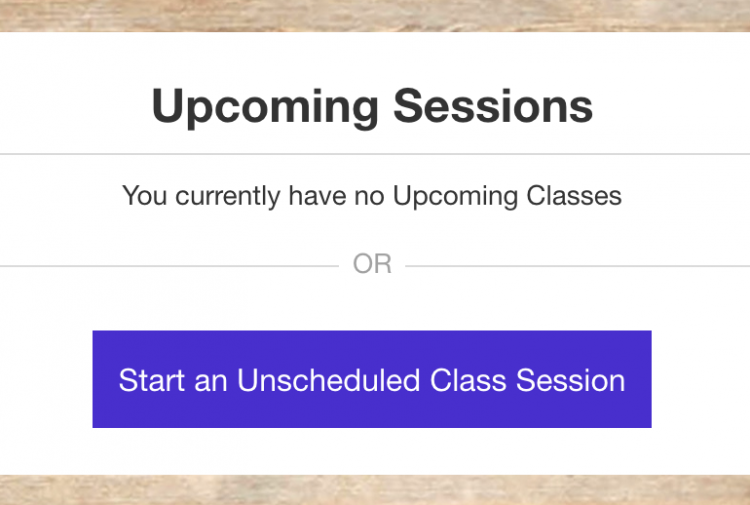
Type the name of the first user to invite. The system will autofill names of matching users; click to select the right one. As you add each one, they’ll be shown in the Student List.
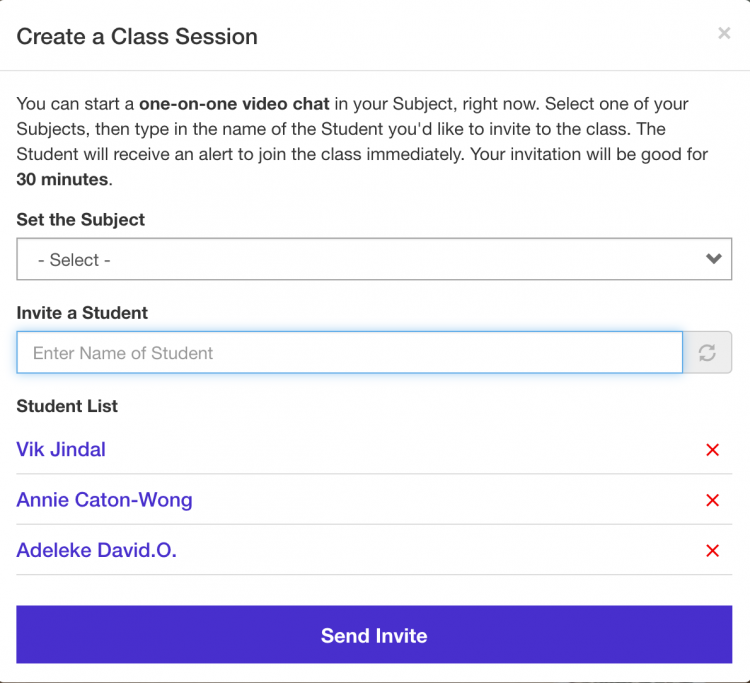
Click “Send Invite,” which sends the invitation to your students and takes you to your video classroom. Be sure to test your audio and video at the prompts. At the same time, invitees will receive a Sivana chat message with a link to join your session. Once they click it, you’ll be in the video classroom together to proceed with your session.
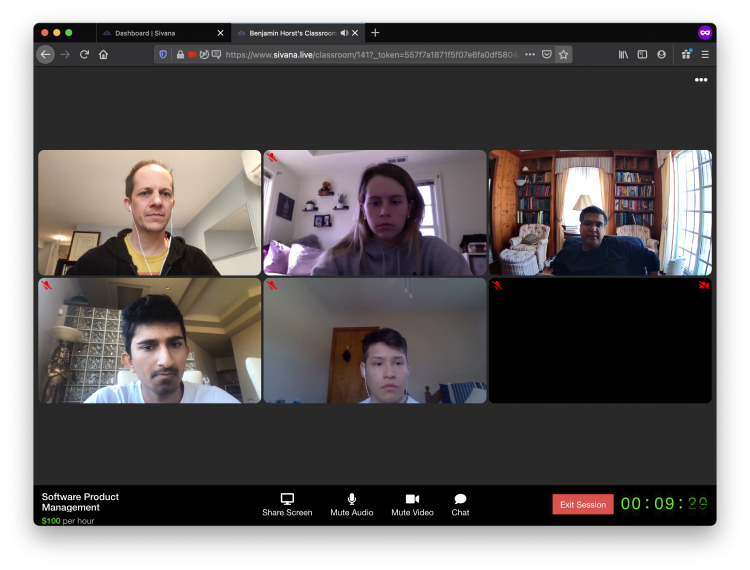
Frequently Asked Questions
Sivana Basics
What is an Instructor?
Everyone can teach others something in life. You don't need an advanced degree in an academic topic to have a skill you can share with others who are excited to learn. Languages, culture, art, hobbies, side interests and life skills like cooking are all valuable skills you can share on Sivana.
If you've lived and learned something along the way, you are an Instructor in our eyes.
At the same time, every instructor in one area is new to another. You can teach others with your expertise, while also learning something else from an instructor in a different subject. Don't hesitate to jump right in!
Is the process of becoming an Instructor complicated?
No, it's quite simple. There is no required vetting or credentialing process. You simply sign up as an Instructor and create subjects on topics that you are interested in teaching and sharing with others.
Are there any restrictions for subjects?
Subjects can be as broad or specific as you like, and as popular or as unusual as the range of your interests. Existing examples include: Mindfulness Meditation, Nutrition and Healthy Living, Guitar, and String Bracelets. Of course, that doesn't rule out academic subjects and tutoring or test preparation either.
How do I decide on a price for my subject?
Sivana's open marketplace model lets you set a price for each subject based on your assessment of its value to your students. For mentorship and coaching, you can even set a price of zero, to let you provide your abilities as a volunteer to help others.
Review what other experts in your area charge. If you offer a unique set of skills or provide more value than other experts, charge slightly more. Also feel free to experiment with your pricing, because you can always adjust it up or down based on the response you receive from potential customers.
How do I make my profile stand out?
It’s important to fill out every description box thoroughly and with thoughtful detail, and explain your experience in a relatable, human way. Add a Subject Cover photo, and record a short intro video. Over time, if your subject is given positive reviews, it will stand out.
Use Sivana's social features to gain followers on your subject. Populating your feed with useful information posts and following other subjects will give users more content to explore and help them make the decision to sign up for a session with you.
Is Sivana free?
Signing up to be a student or an expert, creating subjects, and following other subject feeds are all completely free.
Does Sivana charge a subscription fee?
No. Sivana is an open marketplace that allows students to find expert teachers. The expert sets the rate they charge for each specific subject they offer, so be sure to review that price before starting work with an expert. You will only be charged for the sessions you use.
Does Sivana charge a commission?
Sivana charges a 20% commission fee, which comes out of the experts’ fees. If the subject is free to its students, there is no commission charged.
At the present, Sivana is a public beta technology and has not yet implemented its commission fee structure, so beta users can make use of the platform free of commission until our formal public launch.
Technical Help
How do I become an Instructor?
First, join the community as a user by creating an account at https://www.sivana.live/join . You can create your account by signing in with Google or Facebook, or with any email address.
Then, click your profile icon in the top right of the Sivana site, and in the dropdown window that appears, choose "Become An Instructor" and fill out the additional information requested. Once you’ve done this, you’re officially a Sivana Instructor. You now have the option of creating your own Subjects and setting your availability. For more information, click the box labeled “How it Works”.
How do I create a subject?
After your account is created, a purple box appears at the top of your dashboard feed, with the option to “Create Subject.” If you’re not sure which subjects you’d like to create right now, you can always make one later by clicking on your profile in the top right corner, and selecting “My Subjects.”
How do I make a post in my subject?
Once you’ve become an instructor, you will see an option under the main header to “Make a Post” next to “Write an Article.” You can share a link, post a video or image, or write your own text. If you have more than one subject, be sure to choose the correct subject that you want to make the post for.
Remember that posts are one of the ways potential students will choose an instructor, based on the personality, interests and approaches visible in the way instructors communicate and share information. Try to make your posts fit your personality and style of teaching, which will help attract students who are the best fit for you.
How do I create a video for my subject?
You can use any video-recording device including your computer, phone, or tablet. Simply add the video to your desktop and make sure the format is .mp4. If the video is in .mov format there are simple ways to change it to a .mp4. On a Mac, simply click on the video, press the ENTER key, and change the extension text from .mov to .mp4. The computer will then prompt you to confirm this change and upon confirmation it should be easy to upload it to Sivana.
How do I make a schedule for my availability?
By default, your availability is set to 24 hours a day, 7 days a week. This means a potential new student can attempt to book you for a session at any point in the day! (You have to approve each booking request, but this can still lead to confusion for potential students.)
Click on the calendar icon in the website's header. On the left sidebar, click the box that reads “Set Your Teaching Schedule Availability.” You can then choose for each day of the week your specific hourly availability. To block more specific times, set your general Availability for the day (e.g. '9 AM-5 PM') on this page, return to your Schedule, then click an open time on the calendar to restrict additional time within the initial period.
The calendar adapts to your timezone, so when you set your availability based on your working hours, it will automatically display the local hours for site visitors from other time zones around the world.
How to improve your Sivana Profile
- You are an instructor in a specific topic, so make sure you know it front to back! Practice how you will give lessons, focus on your technique, and make sure you have the resources required to teach remotely. Sivana allows you to maximize your efficiency on the platform by clearly defining the subjects you will teach, your schedule, and the materials needed to learn the subject. The quality of your lessons is obviously important to retaining and expanding your business, and it is essential to hit the ground running!
- Make sure to remain active on Sivana to attract clients. Sivana allows you to post videos, articles, and anything else about your subject. Demonstrating an interest in your subject is key to attracting clients! High quality posts will lead to followers, and this can make your profile stand out from others who offer similar lessons. You can also follow other subjects and see what other experts are doing. Your activity on the platform will help you stand out.
- Sivana site features help to automatically promote you, and people can search or browse by categories to find your subjects. However, a essential way to expand your business is to use your own network. Post a link to your subject page on your social media accounts and share it with existing customers. This is one of the best ways to get new clients and raise awareness of the expertise you offer.
- Ensure your video communication looks professional. Make sure your wifi is fast enough to handle video calls. Raise your computer camera slightly above your head for a better angle. Make sure that you have a bright source of light behind the camera and not behind you. Remember that people can see what is behind you, so make sure to have a clean, presentable background.
- Set a rate that values your skills and teaching ability fairly. Counter-intuitively, many online tutors will undervalue their services. Don’t be scared to charge a little more than you think is reasonable, because clients are often willing to pay more than you might think. If you have followed the above instructions you can set a higher rate to reflect the high quality of your work. Don’t forget that the more you put into Sivana, the more you can get out of it!
Tips for Instructors
- Get to know the person you are teaching
Relax and establish a cordial relationship with the person you are teaching. It is important to be friendly and get to know each other. This helps to build a relationship that will make you a more effective tutor and your student a more effective learner. In addition, this is a key part of growing your business because many people find tutors based on recommendations.
- Be patient
Topics that seem simple to you may take several explanations for the person to grasp. Take your time and do not rush over fundamentals; this will pay dividends when getting into more complex material.
- Admit when you are confused or do not know the answer
Making up an answer or pretending that you know everything does more harm than good. The person you are teaching does not expect you to be able to answer every question. Should you not know the answer, admit it, and after the session or while they are working on something, research the solution.
- Listen
Listen intently to questions and make sure you fully understand concerns. This will help you to better address what is confusing your student.
- Avoid yes or no questions
Yes or no questions do not challenge the student to fully showcase an understanding of the material. Instead, having the student explain the material to you ensures that they fully understand.
- Set goals
Setting goals for your session and the course of tutoring allows for a learning program to be established and enables both participants to feel accomplished at the end of each session. Take time to understand what the student wants to get out of this partnership and prioritize that learning.
- Show your excitement about the material
You are passionate about what you are teaching. Convey this to the student to build their excitement and commitment to learning.
Once a student and instructor connect, our calendar feature lets the student proactively book a meeting time based on the preset schedule provided by the instructor. Finally, when the time arrives, both student and instructor visit the video classroom page to carry out the browser-based video learning session.
Advice from Instructors
At Sivana, instructors can structure their lessons in any way to best suit their students. Sometimes this freedom of choice can be daunting for first-time and seasoned instructors alike. To help get you started, here are several teaching tips for each subject category from fellow Sivana instructors.
Personal Improvement and Health
Varsha Mathur, a relationship coach, advises instructors to craft their sessions according to the client’s unique goals. This means some or even most of the planning occurs during the first several minutes of a session. She offers tips on how to do so:
● Listen to the client. Each client’s situation is unique to them. This means that, in Mathur’s words, “what works for [one person] may not work for someone else.” Therefore, it’s important for the instructor to personalize the session so the client can get the kind of advice they are seeking.
● Let the needs of the client guide your session’s structure. This goes hand in hand with the listening tip. Mathur usually prepares specific exercises for her clients, but she finds that some people may be looking for broader advice. For these clients, she gives them a general coaching session.
● Be prepared to have longer or shorter sessions than you initially expect. Counseling and therapy sessions often cover heavy topics, which means the client may have a lot to unpack. The client may also hesitate to reveal information, in which case they might benefit from multiple short sessions as opposed to one long session. Mathur has observed that her sessions usually run between an hour and an hour and a half.

Visual and Performing Arts
Editorial Makeup Artist Kanako Kawabe and home music producer David J. Michalak have tips on how to make the classroom environment welcoming to the student:
● Provide an engaging hands-on experience by guiding rather than instructing your student. Art is a creative field and it’s important to let students follow their inspiration without enforcing too many potentially restrictive rules. This way, as Kawabe puts it, they can “explore safely” and even “bend the rules” to discover their budding unique artistic style.
● Understand what your student wants to get out of the session. This is important in tutoring regardless of subject. However, it’s even more critical in artistic fields, where there is no universal right or wrong answer. There are many different ‘correct’ approaches in the arts, so the instructor should get a sense of which style their student is interested in to maximize learning. Michalak asks his students what they want their song to sound like and what they want to achieve before launching into a session.
● Inspire your students by introducing them to established artists/performers. Once your student finds the artistic style they like, showing them examples of work from other artists can help get their creative juices flowing. Kawabe draws inspiration from makeup artists who share their work on YouTube channels, Instagram, or other social media.


Academics and Foreign Languages
These memorization-based and often complex subjects call for clear lesson plans. French professor Ann Bayliss points out ways in which the instructor can make even the most technical aspects of language learning fun:
● Plan your lesson based on the student’s existing passions to make dry and abstract concepts accessible. For the musically-inclined student learning French, French songs and music vocabulary will help make their language learning journey fun. If they’re the artistic type learning math, bring paintings and art supplies into problem worksheets.
● Know that your own interests may be different from your student’s, which may impact the sessions. Bayliss remarks that since she’s more of an artistic person, she has consistent success teaching students interested in the arts, but has had less success with non-artistic ones.
● Understand each student’s way of learning. Some students may grasp concepts quicker than others. Some might be visual learners and others auditory learners. Bayliss finds there are two types of students. One type learns best in a structured setting with plenty of guidance. In this case, the instructor should prepare lesson plans carefully and, “create quizzes and chart progress.” The second type tends to ask questions to grow their pre-existing understanding of a language. For these students, Bayliss advises the instructor to, “be prepared for surprise questions” which may challenge their own knowledge.

Sports and Physical Activities
Learning sports and other physical activities requires an abundance of hands-on practice. Telemark skier Jeff Horst suggests making use of online sessions, videos, and in-person meet-ups if possible:
● Go over rules and techniques during the initial Sivana sessions. A majority of physical activities are rule-based, so a student who is new to the activity needs to know the basic rules first. Some activities, like telemark skiing, require the student to memorize a variety of techniques. Horst usually explains the rules of telemark skiing during the first few sessions with a new student.
● Send videos of the sport / physical activity in action. Instructors can film themselves doing the activity and break down the videos during a Sivana session with their students.
● Consider an in-person class if necessary and feasible. Some physical activities, such as dance and yoga, can be done via video conferences. Others, particularly sports, are more difficult to capture on a screen. For telemark skiing, Horst would, “get together [with his student] on some beginner slopes” so they can get firsthand experience.

